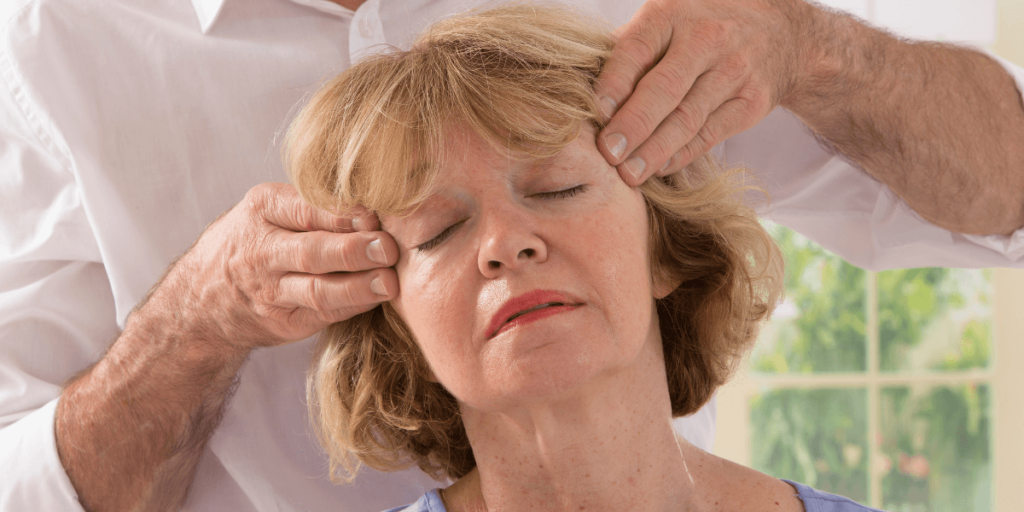Cranial Sacral Therapy, also known as Craniosacral Therapy, is a non-invasive, complementary procedure performed to relieve compression in the skull and spinal musculoskeletal system. It involves applying gentle pressure to the head, neck, and spine to decrease stress, discomfort, and pain caused by compression.
Cranial Sacral Therapy can treat a wide range of health conditions, such as chronic pain, migraine headaches, neuralgia, multiple sclerosis, complex regional pain syndrome, fibromyalgia, and neurodegenerative diseases.
This technique also treats traumatic brain injuries, concussions, autism, stress-related disorders, impaired motor coordination, and spinal injuries.

Benefits of Cranial Sacral Therapy
Cranial Sacral Therapy is derived from Osteopathic Manipulative Treatment or OMT. It is a mindful and non-invasive technique performed by massage therapists, chiropractors, and osteopaths between the cranium and sacrum. The gentle pressure applied between these areas releases myofascial structures to normalize sympathetic nerve function. OMT can help to diagnose, treat and prevent illness or injury.
Here are just a few benefits of Cranial Sacral Therapy.
Reduces Fibromyalgia Symptoms
Fibromyalgia is a musculoskeletal disorder characterized by pain, fatigue, lack of energy, trouble sleeping, headaches, memory problems, depression, anxiety, muscle cramps and twitches, tingling, and numbness in the hands.
Cranial Sacral Therapy focuses on your musculoskeletal system to promote the natural healing process. A study conducted in 2010 evaluated the effects of Craniosacral Therapy on patients with fibromyalgia.
The study included 92 participants who received Cranial Sacral Therapy and placebo therapy for four to five months. Researchers concluded that patients who receive therapy had improved symptoms and reduced pain.
Relieves Stress and Anxiety
Cranial Sacral Therapy is an effective treatment option for people with stress, depression, and anxiety. A 2011 research study found that patients with fibromyalgia who undergo long-term craniosacral therapy have improved quality of life, reduced stress, and anxiety.
Cranial Sacral Therapy regulates the central nervous system by activating the autonomic nervous system, providing feedback to the brain and spinal cord. As a result, the brain regulates the hormonal, digestive, and pulmonary systems, allowing the body to receive enough oxygenated blood to release pressure on muscles.
Eases Asthma Symptoms
Dust, mold, perfumes, cigarette smoke, and chemical fumes are leading triggers of asthma attacks, causing the patient to seek immediate medical treatment in the emergency room. Antibiotics and beta-blockers are classes of medication that can increase asthma incidence.
On the other hand, Cranial Sacral Therapy can help relieve asthma symptoms. One 2006 research study concludes that the non-invasive treatment can effectively ease asthma symptoms in patients. However, researchers do not recommend the combination of these treatment options for asthma patients.
Relieves Chronic Pain
A recent meta-analysis and systematic review study that evaluated randomized control trials conclude that Cranial Sacral Therapy is an effective treatment option for treating chronic pain. This could be because the therapy diagnoses and treats abnormal somatic patterns through the fascial and central nervous system to relieve chronic pain symptoms.
It also addresses musculoskeletal imbalance, myofascial and immune system dysfunction, trigger points, elevated heart rate, hypertension, stress, anxiety, and insomnia associated with chronic pain. The therapy restores the central nervous system’s fluids and membranes by releasing pressure on areas around the brain and spinal cord.

How is Cranial Sacral Therapy Performed?
Cranial Sacral Therapy is a sophisticated treatment option that follows a step-by-step approach, and a qualified osteopath or chiropractor performs the therapy. Experts recommend wearing comfortable clothes during the session, which takes about 60 minutes.
The practitioner will ask you to lie down on your back on a comfortable massage table. The therapist will then start the procedure by applying gentle pressure to your head, abdomen, and feet, depending on your condition.
The pressure the practitioner applies to your body is light and it does not hurt. While using the gentle force, the practitioner will hold your head, sacrum, or feet to evaluate your body’s rhythms.
If the practitioner detects any misalignments or inadequate cerebrospinal fluid flow, they will realign the musculoskeletal system of the sacrum and restore the normal flow of the cerebrospinal fluids.
You will feel various sensations during the procedure, such as cold or hot sensations, numbness in your muscles, deep relaxation, or falling asleep. Bear in mind that you may require long-term treatment to relieve the symptoms of the underlying condition.
Practice Cranial Sacral Therapy
Stacy Renz, an occupational therapist who offers Cranial Sacral Therapy at her yoga studio, Living Room Yoga, in St. Petersburg, Florida works hands-on with her clients. “What first attracted me to Cranial Sacral Therapy is the idea that it gently opens the prana vayus spoken about in yoga. As a yoga therapist as well as an occupational therapist, this felt very congruent with what I was already doing in my practice,” says Renz. “Like yoga, Cranial Sacral Therapy gently restores the flow of energy, contributes to the correction of muscle and soft tissue imbalance, and allows emotional issues seated in the body to be gently brought into awareness where they can be acknowledged, dealt with, and let go of.” At Living Room Yoga, the focus is on healing. Renz offers a variety of programs from yoga to OT and Ayurveda.
To visit with Stacy Renz at Living Room Yoga or to attend a class, check out the studio schedule here.



